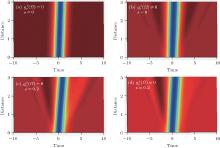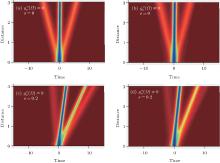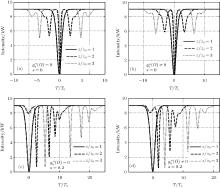†Corresponding author. E-mail: jwg1960@163.com
*Project supported by the National Natural Science Foundation of China (Grant No. 61167004) and the Natural Science Foundation of Inner Mongolia Autonomous Region, China (Grant No. 2014MS0104).
Based on the equation satisfied by optical pulse that is a slowly varying function, the higher-order nonlinear Schrödinger equation (NLSE) including Raman gain and self-steepening effect is deduced in detail, and a new Raman gain function is defined. By using the split-step Fourier method, the influence of the combined effect between Raman gain and self-steepening on the propagation characteristic of dark solitons is simulated in the isotropic fiber. The results show that gray solitons can be symmetrically formed by high order dark soliton, however self-steepening effect will inhibit the formation mechanism through the phenomenon that gray solitons are produced only in the trailing edge of the central black soliton. Meanwhile, the Raman gain changes the propagation characteristic of optical soliton and inhibits the self-steepening effect, resulting in the broadening of pulse width and the decreasing of pulse offset.
Existing in the regime of normal dispersion, dark soliton has attracted more attention in the fields of nonlinear optics[1– 3] and Bose– Einstein condensation.[4– 7] When the dark soliton propagates in fiber, higher-order nonlinear effects will play a vital role if its input power is relatively large and pulse width is shorter than 1 ps. Self-steepening (SS), as one of higher-order nonlinear effects, leads to an asymmetry in the self-phase modulation (SPM)-broadened spectrum of ultrashort pulses.[8, 9] The distortion and aberration in dark soliton pulses propagating in fiber are due to self-steepening, so that propagation characteristic[10– 12] of dark soliton pulses can be widely affected by SS. Generated by the interaction between optical solitons and phonons, the Raman gain needs to be considered if their pulse wavelengths become shorter and their input powers larger. At this moment, SS and Raman gain may not be ignored, so the study of how the combined effect of higher-order effects including Raman gain and SS affects the optical solitons is really necessary. Some researches[13, 14] on SS affecting propagation characteristic of optical solitons have been carried out since 1980s. Govindaraji[13] studied dark soliton switching in nonlinear fiber couplers with gain, however, there were less relevant papers considering both Raman gain and SS effect. The Raman gain and SS effect will become intense if the optical soliton wavelength is relatively short, and they will interact and influence each other in the fiber. Therefore, research which considers the combined effect between Raman gain and self-steepening effect remains to be further conducted. The objective of this paper is to investigate the combined case in the single-mode fiber. The evolution process of picosecond dark soliton pulse propagating in the isotropic medium is simulated and the influence on propagation characteristic is analyzed by using the split-step Fourier method[10] to solve the nonlinear Schrö dinger equation including SS and Raman gain.
When the optical pulse propagates in the fiber, its slowly varying amplitude Q(z, t) satisfies[12, 15]

where β 2 represents the group velocity dispersion (GVD), and the self-steepening parameter s is defined as s = 1/(ω 0T0), where T0 is the pulse width. And the term of Δ β 0 on the right-hand side of Eq. (1) contains nonlinear effects of isotropic fiber, it is defined as

where the effective mode area of fiber is introduced as



Substitution of Eq. (2) into Eq. (1) yields

Let the nonlinear coefficient of electron and parallel Raman gain be defined as 


where 
Let τ and U represent normalized time scale and normalized amplitude and be defined as


where P0 is the peak power of initial input pulse, and α is the coefficient of fiber loss. Considering both self-steepening effect and Raman gain, the normalized amplitude U is found to satisfy the nonlinear Schrö dinger equation such that

where β 2 is the second-order dispersion coefficient. In the normal region (β 2 > 0), equation (8) has dark solution. The parallel Raman gain 
The initial pulse is the dark soliton given by[1]

where I is the amplitude of initial pulse, ξ is the phase of dark soliton, N is the order of dark soliton, for N = 1, 2, 3, respectively, dark solitons are called fundamental dark soliton, second-order dark soliton, and third-order dark soliton. In this paper, for dark soliton, pulse duration T0 = 10 fs, step size Δ z = 1/10000, β 2 = 1 ps2/km, γ = 3 W− 1/km, P0 = 1 kW, and soliton period[10]

the evolution process of optical solitons propagating in the fibers can be simulated by using the method of split-step Fourier transform.
Propagating in the optical fibers, dark solitons neither form a bound state nor follow a periodic evolution pattern in the case of bright solitons. By contract an input pulse with “ tanh” amplitude exhibits an intensity “ hole” at the center. Figure 1 shows the fundamental dark soliton (N = 1) evolution in time– distance space in a range of 0– 3z0 under four different conditions. As seen clearly in Fig. 1(a), fundamental dark soliton pulse would maintain its shape in the normal dispersion region under the condition of considering neither Raman gain 


 | Fig. 1. Temporal evolution of fundamental dark soliton (N = 1) induced under four different conditions over 3 soliton periods. |
Gray solitons[1] can be symmetrically formed by high-order dark soliton with the propagation distance increasing. Figure 3 shows the temporal evolutions of second-order dark soliton (N = 2) over three soliton periods in time-distance space. To be clearer, temporal evolutions are presented in Fig. 4, showing the pulse shapes for soliton periods at z0, 2z0, 3z0, respectively. It is evident from the figure that two gray solitons are symmetrically formed and move away from the central black soliton[1] as the propagation distance increases. At the same time, the width of the black soliton decreases. This behavior can be understood by noting that a second-order dark soliton pulse can form a fundamental black soliton of amplitude 2tanh(2τ )[10] provided that its width decreases to half of the original. It sheds part of its energy in the process, and appears in the form of gray solitons. These gray solitons move away from the central black soliton because of their different group velocities and the number of gray solitons is two. However, as illustrated in Fig. 4(b)
 | Fig. 3. Temporal evolution of second-order dark soliton (N = 2) induced under four different conditions over 3 soliton periods. |
The above analysis indicates the manner in which a pair of gray solitons can be formed from a second-order dark soliton. In particular, the N-th order (N ≥ 3) solitons follow a similar manner, and the number of gray soliton pairs is N − 1.[5] Figure 5 shows temporal evolutions of third-order dark soliton (N = 3) in time– distance space over three soliton periods. To be clearer, temporal evolutions are presented in Fig. 6, showing the pulse shapes for soliton periods at z0, 2z0, 3z0, respectively. It is evident from the figure that two pairs of gray solitons are symmetrically formed and move away from central black soliton as the propagation distance increases. At the same time, the width of the black soliton decreases. This behavior can be understood by noting that a third-order dark soliton pulse can form a fundamental black soliton of amplitude 3tanh(3τ ) provided that its width decreases by a factor of 3. It sheds part of its energy in the process, and appears in the form of gray solitons. These gray solitons move away from the central black soliton with different group velocities. However, as illustrated in Fig. 6(b)
 | Fig. 5. Temporal evolutions of third-order dark soliton (N = 3) induced under four different conditions over 3 soliton periods. |
Optical soliton pulses are shaped by the balance between GVD and SPM. In the nonlinear Schrö dinger equation which governs the normalized amplitude U under condition of both self-steepening effect and Raman gain, 
| 1 |
|
| 2 |
|
| 3 |
|
| 4 |
|
| 5 |
|
| 6 |
|
| 7 |
|
| 8 |
|
| 9 |
|
| 10 |
|
| 11 |
|
| 12 |
|
| 13 |
|
| 14 |
|
| 15 |
|
| 16 |
|
| 17 |
|
| 18 |
|
| 19 |
|
| 20 |
|
| 21 |
|
| 22 |
|
| 23 |
|
| 24 |
|
| 25 |
|





